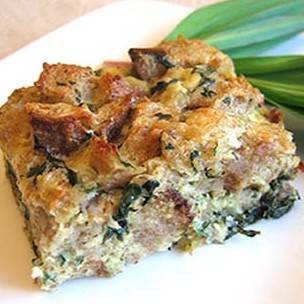 The community supported agriculture season is less than a month away. For many people, being part of a CSA will be hard, not because they don’t like vegetables, but because they are used to having recipes dictate their lives.
The community supported agriculture season is less than a month away. For many people, being part of a CSA will be hard, not because they don’t like vegetables, but because they are used to having recipes dictate their lives.
Somewhere, as we moved along the post-WWII path of convenience foods, we forgot that the most convenient thing of all is to cook what is already in our fridges, cupboards, and backyards. Running to the grocery store on the outskirts of town at 5 o’clock for missing ingredients is anything but convenient. And for every minute you spend in the store beyond twenty, you are going to be spending more money. The people who design store layouts get paid to make it as difficult as possible for you not to part with your cash.
And speaking of cash, since we are running head long into a second era of Robber Barons, it seems appropriate to revisit that creature of economic convention, the casserole. Historically or prehistorically, if you consult the Oxford Encyclopedia of Food and Drink in America, casseroles were more stew-like in nature evolving into elaborate concoctions encased in pressed rings of rice or mashed potatoes. However by the 1890s, casseroles in America had become a way of stretching proteins and making do. And, by the 1970s, well… it wasn’t pretty.
But that’s not to say that the casserole wasn’t being milked for all it was worth commercially. Stratas, which are ancestors of the modern casserole and started out as layered, eggless bread gratins, became a ubiquitous brunch dish with the publication of Julee Rosso and Sheila Lukins’ Silver Palate Cookbook in the 1980s. In that, stratas are typically made with white bread and are better if allowed to rest overnight before baking; they often are relegated to holiday meals.
However, it is possible to make their unlayered, humble cousin, the savory bread pudding in a couple of hours start to finish using things you probably already have on hand. Bread pudding, whether savory or sweet, is a great way to use up leftovers. Hence, Pekara’s amazing sweet bread pudding is made from its equally amazing cinnamon rolls, albeit a day old.
This recipe is very flexible. Depending upon when you make it, you may be able to use some plants from your yard and area woodlands. In the spring, wild ramps and mushrooms, a handful of tiny dandelion greens, and a few spears of asparagus are great additions. Keep the pudding vegetarian or add a quarter cup of diced ham. In summer, add a handful of sautéed diced zucchini and peppers to the greens, and top the pudding with some thinly sliced tomato. You also can add a couple of pieces of crumbled bacon. If you are making the pudding in the fall, add half a chopped tart apple, a quarter cup of cooked pork or soy sausage, and some thyme and sage. Season the pudding with fresh or dried herbs like dill, chives, chervil, and tarragon in the spring, and herbs like basil and oregano in the summer.
For bread, we typically have Pekara whole wheat sourdough on hand, but any substantial whole grain bread will work. Use more or less cheese depending upon your preference. Prairie Fruits chevre and local and regional cheddars are available at Common Ground and World Harvest. Bread puddings depend on good eggs. Moore Family Farm and Triple S eggs are available at Common Ground, where you’ll also find local Kilgus milk.
Savory Bread Pudding
Preheat oven to 350 degrees F. Butter an 8 x 8 metal or glass baking dish.
- 2 cups of whole milk or 2 cups of skim plus 1 T butter
- ¼ cup of sliced green onions, wild onions, or diced slicing onion
- 1 t dried or 1 T fresh herbs
- Dash pepper
- ¼ t of salt
- 5 cups of dense, whole wheat bread cut into cubes ½- to 1-inch square
Place bread in a large mixing bowl. Heat milk, onion, pepper, and salt to boil. Remove from heat and allow to steep for five or more minutes. Pour still warm milk over bread. Stir to coat, being careful not to break up the bread.
- ½ T butter
- 2 t olive oil
- 5 ramps or 1 clove garlic minced
- 2 c spinach or other seasonal greens
- Handful of chopped, seasonal vegetables (optional)
- Handful of chopped mushrooms (optional)
- ¼ c chopped ham (optional)
- Salt and pepper to taste
Heat butter and olive oil. Saute vegetables with salt and pepper. Pour over bread. Add meat if using. Fold gently into bread mixture.
- 4 large or jumbo eggs
- ¼ c goat cheese or cream cheese (or use the larger amount of shredded cheese below)
- 1/3 c to ¾ c shredded cheddar or other flavorful cheese
- Additional salt and pepper
- 1-2 T grated cheese for top of pudding
Beat eggs in a separate bowl. Pour into bread mixture. Add cheese. Stir. Pour into prepared baking pan. Top with additional cheese. Bake for 40 to 45 minutes until center is set and casserole is golden brown. Serves 6.
Note: If you double the recipe in a 13 x 9 pan instead of two, 8 x 8 pans, the baking time will need to be increased by up to 10 to 15 minutes as there will be less surface evaporation.








